It’s no easy thing picking yourself up off the mat after getting sucker punched . . . or getting almost diesel mileage out of a gas engine.
But, VW’s trying.
The just updated 2019 Golf Sportwagen won’t be available with a 50 MPG-capable TDI diesel – which you can no longer get in any new VW because of the evil fallout from the emissions “cheating” scandal. 
It does, however, come standard with a new 1.4 liter engine that will probably manage 40 MPG on the highway.
That’s about 6-7 MPG better than the 1.8 liter (gas) engine that was last year’s standard – and only available – Sportwagen engine.
And VW hasn’t ditched the 1.8 liter engine; it’s still available optionally for people who prefer a bit more power – and don’t object to a bit less gas mileage.
The new 1.4 liter engine also comes standard with a six-speed manual transmission – an upgrade over the five-speed manual that came standard in last year’s base Sportwagen with the 1.8 liter engine.
Even better, these two upgrades – the new engine and the new transmission – only add $210 to the 2019 Sportwagen’s base price vs. last year.
And the wealth of room this alternative to crossover SUVs gives you?
That’s also included, no extra charge.
The Sportwagen is a wagonized version of VW’s compact-sized Golf hatchback. It’s for the person who would like the cargo space and versatility of a small crossover SUV . . . but who doesn’t want to own a crossover SUV.
The Sportwagen actually has more cargo space than many compact-sized crossovers, including VW’s own Tiguan – which maxes out at 56.1 cubic feet vs. 66.5 cubic feet for the SW.
And you can get the Sportwagen with a manual transmission in any trim – and with either engine and with (or without) all-wheel-drive. That’s several things you will have trouble finding in a crossover SUV – compact-sized or otherwise.
It also comes with a lower price tag than you’ll find affixed to most small crossovers – $21,895 for the base S trim with the new 1.4 liter engine, six-speed manual transmission and front-wheel-drive.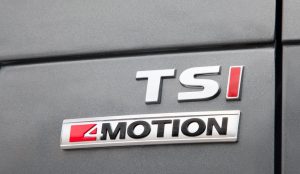
An eight-speed automatic (also new) can be selected in lieu of the six-speed manual, bumping the MSRP of the S trim to $22,995.
For reference, the front-wheel-drive’s Tiguan’s base price is $24,595.
Sportwagens with the optional 4Motion all-wheel-drive system come with the larger 1.8 liter engine that was standard equipment in all Sportwagens last year; it’s more powerful (168 hp) but doesn’t get 40 MPG.
It is available with a six-speed manual transmission, too – something you can’t get in a Tiguan at any price.
And a Sportwagen with the 1.8 engine, the six-speed manual transmission and 4Motion all-wheel-drive still costs $200 less than a FWD/automatic-only Tiguan . . .
Just $24,395.
A six-speed automated manual is available optionally; so equipped, the Sportwagen’s price climbs to $25,495 – but that’s still $100 less than a FWD Tiggy.
A top of the line SE trim with the 1.8 liter engine, 4Motion and the automated manual transmission stickers for $29,995.
In addition to almost getting 40 MPG without a diesel engine, the 2019 Sportwagen is available with a Driver Assistance package that bundles Automated Emergency Braking with Forward Collision Warning, Pedestrian and Blind Spot Monitoring and Rear Traffic Alert.
SE trims can be ordered with Adaptive Lighting and Lane Keep Assist.
The previously available SEL trim has been discontinued.
New 1.4 liter engine almost makes up for the loss of the VW’s brilliant TDI diesel engine.
Crossover cargo room . . . without the crossover.
Both of the Sportwagen’s available engines are still available with manual transmissions – and they’re both six-speeds now.
WHAT’S NOT SO GOOD
No 50 MPG-capable diesel engine – over infinitesimal variations in exhaust emissions of no concern to the environment or public health.
AWD isn’t available with the new 1.4 liter engine.
The more powerful 1.8 liter engine is now only available with AWD.
VW used to be the only company that sold a whole line of affordable diesel-powered cars.
Almost every model they made – the Beetle, Golf, Jetta, Passat and Touareg – was available with a turbo-diesel engine and some of these could deliver mileage as good as any hybrid while costing less than a hybrid.
But now the diesels are gone – taken off the market for “cheating” Uncle’s emissions certification tests.
The cars’ actual emissions were “cleaner” than those of cars made in the early 2000s and only fractionally less “clean” than the near zero-emissions standards of today – and so weren’t a big deal as far as air quality or health. But it was a very big deal to affront the Authority of Uncle – and for that, VW was almost driven into bankruptcy.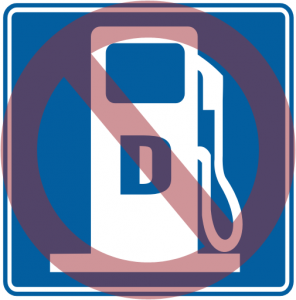
And of course, the diesels have been blackballed, probably for good.
But without its diesels, VW has lost a major selling point – almost hybrid mileage – and VW still has to meet Uncle’s MPG mandates.
The Sportwagen’s new 1.4 liter engine has been put under the hood to try to deal with that dilemma. It’s not a diesel, of course – but its mileage is within 8-10 MPG of what the force-retired TDI engine was capable of delivering.
Official numbers weren’t available when this review was written in mid-October, but the same 1.4 liter engine in the 2019 Jetta rates 30 city, 40 highway.
That is at least decently close to the formerly available TDI engine’s 31 city, 46 highway. And the 1.4 engine burns regular unleaded – cheaper than ultra low sulfur diesel. No need to top off a DEF tank or deal with a particulate trap, either. 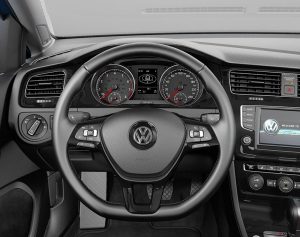
The 1.4 liter engine also makes almost as much torque as the larger (and still available) 1.8 liter engine: 184 ft.-lbs vs. 199 ft.-lbs.
Both of these engines also make that torque at a very diesel-like 1,600 RPM.
It’s not quite as much torque as the TDI diesel engine produced – 236 ft.-lbs. – but the gas engine does make its peak torque lower in the powerband (1,600 RPM vs. 1,750 RPM for the diesel) which means it’s available sooner.
And the horsepower made by the 1.4 liter engine is dead heat: 147 vs. 150 for the old TDI.
You can go with the standard six-speed manual or select the optional eight-speed automatic, both of which have leverage advantages over last year’s standard five-speed manual and six-speed automatic.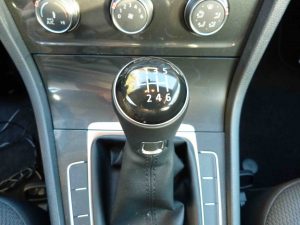
However, you can’t get the optional 4Motion all-wheel-drive system with the 1.4 liter engine. Whether you go manual or automatic, you’ve got to go front-wheel-drive.
On the upside, the 1.4 liter engine is available in both the standard S and the higher-line SE trim, which comes with upgraded amenities such as a larger/nicer 8-inch touchscreen.
On the downside, the more powerful 1.8 liter engine (168 hp) that was standard and could previously be purchased in FWD versions of the Sportwagen now comes paired only with the 4Motion all-wheel-drive system.
Put another way, if you want more power – and more performance – you have to pay more now.
This, incidentally, isn’t VW price gouging you. It’s VW coping with necessity.
With Uncle.
You see, the more powerful 1.8 liter engine isn’t almost-diesel efficient. Its lower MPG numbers make it a liability for VW as far as Corporate Average Fuel Economy (CAFE) regs are concerned. Even with FWD (as was available last year) the best it managed was 25 city, 34 highway.
Those numbers drag down VW’s overall corporate numbers.
The “solution” – in quotes to emphasize the perverse things car companies are forced to do to meet Uncle’s demands – is to sell fewer Sportwagens with the 1.8 liter engine by making them more expensive.
The 1.4 liter engine is intended to be the 2019 Sportwagen’s volume engine.
The 1.8 liter engine is still available for those who really want the power uptick and are willing to pay extra for it. But that’s Uncle’s way of punishing those buyers for not agreeing with him that a car’s fuel efficiency is its most important attribute.
A six-speed manual is however still standard with the 1.8 liter engine/4Motion combo – or you can opt for the available six-speed Direct Shift Gearbox (DSG) automated manual. It’s a more performance-oriented type of automatic than the eight-speed used with the 1.4 liter engine, designed to bang off extremely quick shifts whereas the new eight speed automatic that comes with the 1.4 engine has multiple overdrive gears and is designed to maximize the efficiency potential of the smaller engine.
The new 1.4 engine – like many of the new turbocharged small displacement gas engines – is almost-diesel torquey. It pulls with the strength of a Clydesdale – even though it’s the size of a pony.
Get it with the manual transmission, though, if you want the most fun out of the thing. The six-speed has tighter gear spacing than the new optional eight speed automatic, for one thing – and for another thing, it is not programmed to upshift into its overdrive gearing as quickly as possible, to maximize mileage.
The six-speed manual is “programmed” by you.
It’s also easy and pleasant to drive. Some cars with manuals can be a chore to drive in traffic, not so much because of heavy clutches (that’s been done away with via hydraulically assisted clutches, which all late model cars with manuals now have) but because of abrupt clutches. They are either engaged – or not – and can be difficult to drive smoothly.
Which gets tiring in traffic.
No issue of that kind here.
There’s enough torque on tap to squeal the front tires, too – which is something you won’t be able to do if you choose the larger/stronger 1.8 engine because its power courses through all four wheels.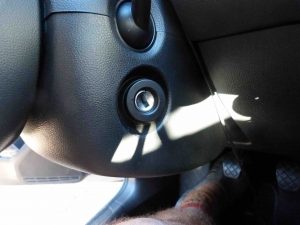
The manual is still the more fun transmission, but the optional DSG transmission is the one you want for best performance. Automated manuals are race car technology, designed to shift faster and more precisely than even race car drivers can consistently.
not even race drivers get it right every time. Automated manuals do.
Regardless of the box – manual or automatic – the Sportwagen itself is more fun than the crossovers it’s a practical alternative to – and not just because it’s available with a manual transmission.
Because it is a sportwagen.
Which means it’s low to the ground rather than jacked-up high. That means its center of gravity is lower to the ground and that means better high-speed handling and superior stability. Crossovers have lots of air rushing underneath – and their mass is higher riding – which makes them inherently less balanced and stable.
They are better in snow, no doubt. The Sportwagen’s 5.4 inches of ground clearance is two inches less than most crossovers have. But then, the Sportwagen isn’t meant for snow days.
It’s meant for fun days – every day.
The Sportwagen isn’t much bigger than the Golf hatchback it’s based on – but it has almost three times the cargo capacity: 66.5 cubic feet vs. 22.8 cubic feet.
It also has more room for cargo than the Tiguan, VW’s compact crossover SUV – which is bigger than the Sportwagen.
And not just with its back seats folded flat, either.
The Tiggy maxes out at 56.1 cubic feet with its second row down and has only 12 cubic feet with the second row up – vs. 30.4 cubic feet behind the Sportwagen’s back seats.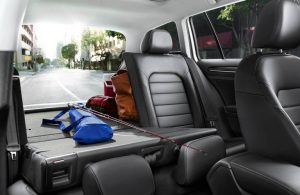
Put another way, the Sportwagen is more practical than the Tiggy, which has very little room for cargo when it is carrying more than one passenger.
Well, unless it snows.
Here the Tiggy – and other crossovers – have the advantage because they’ve got much more ground clearance. Almost eight inches in the Tiggy’s case – which makes it a good snow-day vehicle even if it is a less fun vehicle on other days.
And even if it’ not great in the snow because of its in-the-weeds stance, it’s easier to load stuff in the back for precisely that reason. The cargo floor is 24.8 inches off the pavement; the cargo floors of most crossovers are several inches higher up.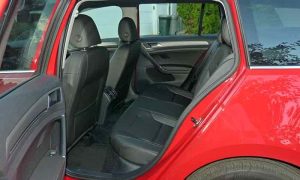
Another Sportwagen plus is plenty of headroom – in both rows – a trait it shares with the Golf and crossover SUVs.
The Sportwagen actually has a bit more headroom than the Golf, surprising given its visually sleeker-looking profile. You get 38.6 inches in front and back; in the Golf, you get 38.4 inches up front and 38.1 inches in the back.
There is a bit less backseat legroom in the VW than in some compact crossovers (including the Tiguan) but the difference is slight – 35.6 inches vs. 36.5 inches vs. the Tiggy – and as it turns out, the Sportwagen’s got more legroom up front: 41.2 inches vs. 40.2 inches.
The new 1.4 liter engine comes standard with an ugsome auto-stop/start system like those almost new cars also have – which means the engine shuts itself off every time the vehicle stops, then automatically restarts when the driver takes his foot off the brake pedal. This is supposed to save gas and may – a little bit. But it also makes the starter battery work harder (re-starting the engine a dozen times every day instead of just twice or so each day) and that will probably mean replacing it sooner. Which may mean spending more money in the overall net.
The Sportwagen also has some pleasantly anachronistic features – including a manual (pull-up) emergency brake lever and (in S trims) a physical ignition key.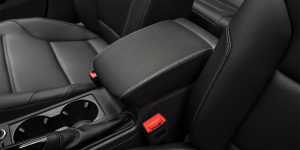
A large and growing number of new cars have an electrically-activated parking brake. It frees up space on the center console to get rid of the manual pull-up emergency brake lever, but you lose the ability to stop the car in a controlled manner in an emergency, if the main brakes (or the electrical system) fail. Also, the pull-up emergency brake is mechanical and simpler than an electrically-activated parking brake. If it ever breaks, it will probably be easier and cost less to fix.
Same goes for the VW’s standard old-school ignition key. You will never have to worry about not being able to start the car because the battery in the fob died or the circuitry in the fob fritzed. Physical keys are also cheap to make copies of.
Keyless ignition fobs often aren’t.
If you prefer to push a button, VW lets you do that, too. Keyless ignition is available optionally.
VW may or may not offer the full LCD gauge cluster it’s putting into other ’19s, including the Passat and Jetta. Given that the Sportwagen is supposed to be the sensible wagen, they may not.
It also explains the . . . sensible standard 15-inch wheels. Upgrade, if you like – but you’re not forced to ride around on harsh-riding, short-sidewall tires that make more noise, don’t last as long and cost more to replace.
Gnomesayin’?
THE BOTTOM LINE
A 50 MPG-capable diesel would have made this car almost irresistible. But it’s still a very appealing package, even without it.
. . .
Got a question about cars – or anything else? Click on the “ask Eric” link and send ’em in!
If you like what you’ve found here please consider supporting EPautos.
We depend on you to keep the wheels turning!
Our donate button is here.
If you prefer not to use PayPal, our mailing address is:
EPautos
721 Hummingbird Lane SE
Copper Hill, VA 24079
PS: Get an EPautos magnet (pictured below) in return for a $20 or more one-time donation or a $5 or more monthly recurring donation. (Please be sure to tell us you want a sticker – and also, provide an address, so we know where to mail the thing!)
My latest eBook is also available for your favorite price – free! Click here. 


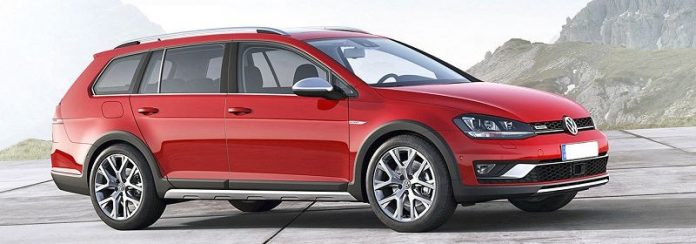



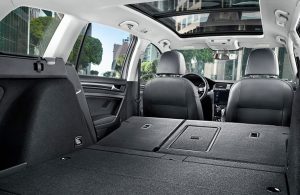
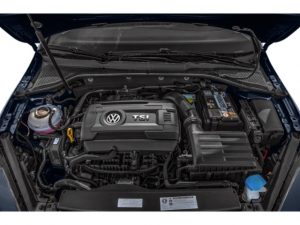

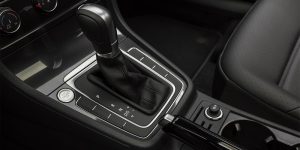
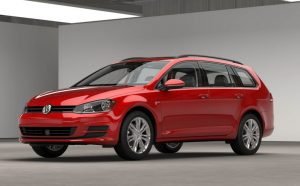









Last year I stopped by the VW dealer. They had 2 left over 1.4 manual Jettas they were clearing out. I test drove and was very impressed. $13500 was the price. Not bad especially with that warranty.
Hi Bin,
For $13k, you should have snapped one up – that was a deal, son!
It was! and I do kick myself over that one. I could have really used it too. I work out of state and my current car has enough miles to worry me – ’98 Jetta TDI is at 465,000 miles.
Funny thing is I pulled over because I had got a call from work to not come in – cutbacks. I was next to the dealer so I figured I’d have a look at the new models before turning around to go back home. Ain’t that how it goes.
Hi Bin,
I think we all have a story along those lines!
Mine actually relates to the SD-455 article of the other day. I could have bought one – a ’74, Buccaneer Red – for $5,800… back in 1987. It was well-used, but still running and driving. Problem was, I was a kid with no money and $5,800 might as well have been $580,000.
Today, of course, any SD car is a six figure car.
You could have really made some money with that one! So many desired the Trans-am and are now older & able to afford them. Thats life, deals like these show up when you can’t afford them.
Hi Bin,
The thing is (to me) that it’s not about making money; it is – or was – about the cars. Owning and appreciating them. It is precisely the people who regard them as investments (might as well be paintings or any other fungible thing) who have made them into four-wheeled farberge eggs, beyond the means of most people.
Back in the ’80s, the muscle cars of the ’60s and ’70s were mostly just old cars – and priced accordingly. My high school’s parking lot was full of old Chevelles and Novas and Mustangs. I had a ’78 Camaro. One of my best friends had a ’71 GTX 440.
We were 17-years-old.
Eric, I like your thinking, and writing. You and friends had some descent cars. I was in high school in the early 90’s, those muscle cars of the late 60’s had been snapped up for the most part. We all had early 80’s low powered stuff with emissions air pumps. I and friends made the affordable move to Japanese sport bikes to get our fix. Right after high school, cause you know – parents and all. In fact, I’ve always had one up until recently because I never got that muscle or sports car I always wanted. I’ve always had the practical car or truck and sport bike for fun.
Hi Bin,
Yup! My generation (Gen X) had the good luck to be teenagers and young adults at a time when almost all used cars were pre-computer, most were rear-drive and many either came with or could have come with a V8. IROC-Z Camaros were new when I was in high school, but you could pick up a mid-late ’70s Camaro for chump change and make it quicker than a stock IROC-Z. We had fun!
Quick check of VW’s website shows the manual transmission only available in the S trim. Maybe the website is not up to date with the 2019’s?
My kid has a ’16 Jetta sedan with the 1.4L turbo/5sp layout. She gets 40mpg’s around town with the easy driving she does. Got over 40 on a trip to the beach. I have driven her car and it has good pep. I have a ’14 Jetta sportwagen. (same type of car as in the review, but w/2.5L 5cyl & 5sp). My car has great space, just a little less than a Subaru Outback wagon. Yes, the insides are cheap, and my prediction is the rest of the car will fall apart around the engine. The ’14 was the last year of the 2.5L 5-cyl without any direct injection.
Hi Tom,
I’ve averaged mid-high 30s in the thing, which is admirable for a gas-engined car that’s as heavy as this car (like most new cars) is because of the need to comply with all the saaaaaaaaaaaaaaaaaaaaaaaaaaaaaaaaaaaaaaaaaaaaaaaaafety folderol. If VW could sell this car – but 500 pounds lighter – it would be just as economical as the TDI powered Jettas I drove before they got outlawed…
Eric – do you drive these cars pretty hard or are you easy on the gas? I would probably average low 30s with my heavy foot. I hammer it on the interstates. 80-90.
Hi Swamp,
My pace is probably a bit faster than most, but I make an effort to drive the way I think the typical person drives when I am testing a car that isn’t marketed as a performance car, as I think it’s unfair to readers to beat on (as an example) a car like this and give an unfair impression of its mileage capabilities.
Now, when I get the Mustang GT 500 all bets are off!
Doesn’t everyone drive 80-90? lol. I do and I do it in 15 year old non performance cars. I can’t afford anything fancy. Let me put it differently. I am unwilling to enter into a banking contract to own a car. This way, I can experience many more cars for a lot less money. Foot to the firewall.
Looked it up:
“What is the penalty for not meeting CAFE requirements for any given model year (MY)?
The penalty for failing to meet CAFE standards recently increased from $5.00 to $5.50 per tenth of a mile per gallon for each tenth under the target value times the total volume of those vehicles manufactured for a given model year.”
Not seeing why car manufacturers spend so much money to eke out fractional MPG gains, since the marginal cost for missing the CAFE average for one last car by TEN mpgs is a $550 tax. Why spend $2,000 in equipment to avoid a $550 tax — or alternately, forego $2,000 extra that a consumer would pay for a more powerful engine to avoid that $550 tax?
It doesn’t seem rational, the contortions the car manufacturers are going thru to meet these damn standards.
Hi Jim,
The reason the car industry has gone batty recently – last 3-5 years – and gone over the top with such things as tiny turbo engines, ten speed transmissions, DI, auto-stop, etc. – is because they anticipate CAFE rising to 50-plus MPG. Trump’s election stalled that – temporarily. But they are planning on it being imposed regardless. Even if the feds don’t do so, CA and several other state will on their own.
Calculate the CAFE penalty when the mandatory minimum rises to 54.5 MPG and your fleet average is 31….
Here’s a simple answer for that. Sell only electric cars in the clean air districts. Sell federal standard cars in another. Problem solved. A market will develop for preregistered used cars across state lines.
I like my air cooled square back better.
Ernie!
You know I had one, right?
Mine was a ’69…
Mine is a 68. I learned to drive on one like it. Truly fine economical and worry free transportation. I just bought 4 new tires for $240. Even with inflation these cars are still dirt cheap and indefinitely maintainable. Though I wish I had the carbureted 67.
OH, BTW Eric. Is there any possibility that Ford will loan out a new Mustang GT 500 for you to test drive in the near future?
Hi Allen,
I am expecting a Mustang to show up very soon, actually!
And: Amen in re the property tax on antiques. So far, the bastards haven’t gotten around to sending me a bill for that. But it’s like an anvil held by a piece of dental floss, hanging over my head – and the head of everyone who owns an antique car. Most of us are not Jay Leno. Many of us have owned the car for decades and bought it when it was just an old car and could be bought for not much. Now the thing is worth some money – and I am certain at some point some greedy SOB bureaucrat will turn his attention to taxing them at “fair market value.”
I do recall about 15 years ago, there was a discussion of changing the way autos were assessed in the county I reside in. The board of supervisors were discussing valuing autos by the factory options instead of entry level base value according to Kelly BB. A lot of hell was raised by the citizens. So it was tabled. But I fear if brought up again, the thieving bastards will go ahead with it. Taxpayers be damned!
The VW is ok, but I’ll hold on to my 2012 focus se. The car is a 2.0 hatchback with a 5 speed manual. It averages 37.4 mpg since new and can get 41.2 on the interstate roads. No mechanical or electrical issues what so ever and it is “paid for”. Unlike an SUV, it has depreciated nicely which means county property tax is “bearable”. The county only values my ’84 HO at $200. I pray that they never start valuing it at collector car rates!
You must be one of the few that drives 55 on the freeways. That’s great mileage.
I do a little faster than posted speeds. I’m not gentle nor hard on the car while driving. Unless you buy a ST or RS Focus, a manual gearbox with a 2.0 is next to impossible to get on this car now.
I noticed that. Ford is making 3 cylinder engines and turbo everything. I can’t stand it frankly. I like the idea of a manual focus. The automatic version flat out suck. The 1 second delay between hitting the gas and getting the car to move is too much for me.
Hi Swamp!
I have a rant almost ready about The Turbo Tax…
I have always liked VWs cars. I would like to see a GLI version of this car. That would be irresistable. The GLI Jetta got 22/33 mpg with the manual transmission and had a very strong set of leg muscles that produced tight handling and excellent cornering. It never plowed in the turns and the turbo engine was enough to transfer enough weight so that you could come out of a turn in a flash.
The only concern I have about these cars is that they are turbocharged and they come with VW’s cheap plastic parts in the interior. It is really unknown how long the car will stay solid. I do like this car and the Passat, as it is a bigger car.
I think I’m going to head down to the VW dealer and kick some tires. 65 CuFT of space is no joke either.
Hi Henry!
This car is one of my favorites – because it’s useful, inexpensive and fun. I am very partial to the wagon layout and this one especially because of the interior room vs. the exterior size. If you go see one, drop the back seats and then climb in back. You’ll find you could sleep back there… with your girlfriend!
Sigh, what a beauty! Maybe some day when I’m dead I can finally afford one…..living just takes too much of my resources, lol!